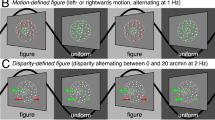Summary
The recognition of misalignment in a pair of lines positioned end-to-end, as when setting a vernier scale, presents a simple problem in the detection of self-congruence. The accuracy with which this task can be performed has been measured both in normal vision and in the absence of retinal image motion; it is found that in the latter case the precision of the setting is decreased when the gap between the ends of the lines is small, but that the reduction in accuracy is not significant when the separation of the lines is increased to 30 min. arc. A search has been made for eye movements generating patterns of scanning activity designed to test the self-congruence of the vernier lines but without success, the distribution of spontaneous eye movements appears to be a function of the subject and not of the target lie is viewing.
The reduction of vernier acuity in stabilized vision indicates that when retinal image motion is absent, the resultant pattern of neural activity is less well defined, this is ascribed to the loss of dynamic lateral inhibition effects but the reduction which occurs as the gap between the lines increases can be attributed to random neural events becoming confused with the stimulus; this hypothesis has been tested by the introduction of visual “noise” which is also found to reduce acuity.
Similar content being viewed by others
References
Anderson, E. E., and F. W. Weymouth: Visual perception and the retinal mosaic. Amer. J. Physiol. 64, 561 (1923).
Barlow, H. B.: Retinal noise and absolute threshold. J. opt. Soc. Amer. 46, 634 (1956).
Clowes, M. B.: Some factors in brightness discrimination with constraint of retinal image movement. Opt. Acta 8, 81 (1961).
Clowes, M. B. and R. W. Ditchburn: An improved apparatus for producing a stabilized retinal image. Opt. Acta 6, 252 (1959).
Ditchburn, R. W., and D. H. Fender: The stabilised retinal image. Opt. Acta 2, 128 (1955).
Fender, D. H., and P. W. Nye: An investigation of the mechanisms of eye movement control. Kybernetik 1, 81 (1961).
Hebb, D. O.: The organisation of behaviour. New York: John Wiley and Sons 1949.
Jacobson, H.: The information capacity of the human eye. Science 113, 292 (1951).
Kelley, D. H.: Effects of sharp edges in a flickering field. J. opt. Soc. Amer. 49, 730 (1959).
MacKay, D. M.: Perceptual stability of a stroboscopically lit visual field containing self luminous objects. Nature (Lond.) 181, 507 (1958).
MacKay, D. M.: Anomalous responses as clues to visual organization. Conference on Cerebral Systems and Computer Logic, California Institute of Technology, Pasadena, U.S.A., 1960.
Neumann, J. v.: Probabilistic logic and the synthesis of reliable organisms from unreliable components. Automata Studies. Edit. by C. E. Shannon and J. MaCarthy, p. 43. Princeton: University Press 1956.
Ogilvie, J. C., and M. M. Taylor: Effect of orientation on the visibility of fine wires. J. opt. Soc. Amer. 48, 628 (1958).
Platt, J. R.: Functional geometry and the determination of pattern in mosaic receptors. Symposium on Information Theory in Biology. Edit. by M. P. Yockey, R. L. Platzman and H. Quastler, p. 371. New York: Pergamon Press 1958.
Ratliff, F., and H. K. Hartline: The responses of Limulus optic nerve fibers to patterns of illumination on the receptor mosaic. J. gen. Physiol. 42, 1241 (1959)
Ratliff, F.: Inhibitory interaction and the detection and enhancement of contours. Sensory Communication, Edit. by W. A. Rosenblith, p. 183. New York: John Wiley and Sons 1961.
Reichardt, W.: Über das optische Auflösungsvermögen der Facettenaugen von Limulus. Kybernetik 1, 57 (1961).
Reichardt, W., u. G. MacGinitie: Zur Theorie der lateralen Inhibition. Kybernetik 1, 155 (1962).
Weinstein, C., et A. Arnulf: Contribution à l'etude des seuils de perception de l'œil. Comm. Lab. Inst. Opt. 2, 1 (1946).
Whittaker, E. T., and G. Robinson: The calculus of observation, p. 324. London: Blackie 1924.
Author information
Authors and Affiliations
Additional information
Now at California Institute of Technology, Pasadena, California, U.S.A.
Now a guest worker at National Physical Laboratory, Teddington, England.
Rights and permissions
About this article
Cite this article
Fender, D.H., Nye, P.W. The effects of retinal image motion in a simple pattern recognition task. Kybernetik 1, 192–199 (1962). https://doi.org/10.1007/BF00290747
Received:
Issue Date:
DOI: https://doi.org/10.1007/BF00290747




